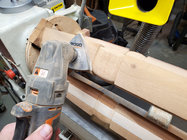I wish I could tell you that from day one I was doing a great job of sanding my pieces. Truth is, sanding is an acquired skill. I'm amazed when beginners bring their work to the meetings. The scratches are so obvious and deep. If I don't explain to them what's wrong, they would be happy with it. I could write a book on sanding techniques, for different items. I have at least 6 or 7 different sanders, angle drills, inertia, extensions, pads, soft pads, dense pads, on and on. For my big urns, the outside of most bowls I prefer, my to-go tool is a 5 in Festool rotary sander. Today I purchased a Festool RO 125 FEQ rotary and non-rotary sander. I seem to be in the minority with the 5 in discs. I used to keep it a secret. No real woodturner would use such a large sander. When I mentioned this to my good friend Steve Worcester, owner of turningwood.com, where I buy my sanding supplies, he said that I was right, that I was in the minority. He then added, only me and David Ellsworth buy the 5 in discs from him! That's when I felt that I could come out of the closet, that I could open my doors and let everyone know that sometimes if the works call for it, I use 5 in discs. They really speed up my job, especially with my large Koa and or Milo urns. I figure that if it's good enough for David, is good for me.
I have asked Steve Worcester to do an IRD about sanding your work for our club. He is putting things together and hopefully, soon he will be ready.
I have asked Steve Worcester to do an IRD about sanding your work for our club. He is putting things together and hopefully, soon he will be ready.

